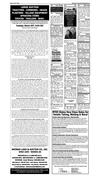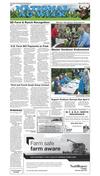031715_YKMV_A13.pdf
shop online at www.missourivalleyshopper.com
March 17, 2015 • Page 13
NATIONAL
AG WEEK
March 15 - 21, 2015
THANK A FARMER
Where Would YOU be Without Agriculture? Naked and Hungry.
National Ag Week is a time to recognize and celebrate the importance of agriculture.
2015 Synchronization Protocols
BROOKINGS — With calving underway, next year’s
calf crop may be the last
thing cattle producers are
thinking about, but according to Robin Salverson, SDSU
Extension Cow/Calf Field
Specialist, it’s never too late.
“With bull sales underway
and 2015 AI beef sire directories available, it is time to
think about breeding season
- especially if you will be
using synchronization,” Salverson said. “Depending on
which protocol is selected, it
could be more than 39 days
from start of the program to
artificial insemination. This
means, if you begin breeding May 13 for a February 10
calving date, you will need to
start synchronizing heifers
April 3.”
Based on research
data and field use the Beef
Reproduction Task Force
composed of representatives
of AI and pharmaceutical
companies, veterinarians,
and reproductive specialists, have developed a list of
synchronization protocols
recommended for heifers.
“There are some great
apps available to cattle
producers that provide synchronization and breeding
calendars for both heifers
and cows,” Salverson said.
“Take note that not all protocols are for both cows and
heifers. There is a difference
in physiological response
between heifers and cows.
It is important that you do
not use a cow protocol on
heifers.”
Likewise, Salverson said
producers need to follow
the protocol, give the proper
hormone injection or insert
at the right time and don’t
expect to jump start all heifers that are not cycling.
She encourages producers to follow Beef Quality
Assurance guidelines when
giving injectable hormones.
“Giving the injection in the
rump because it is administered “closer to the ovary” of
the heifer does not increase
the efficacy or speed of
the hormone, Salverson
explained. “All drugs must
enter the blood system and
travel to the heart and lungs
before reaching the target
organ (i.e. ovaries).”
She reminded cattle
producers that the adage
more is always better does
not work with melengestrol
acetate (MGA). “First, it is
illegal to use MGA off label.
Secondly MGA is absorbed
in the fat and will take longer
to clear from the heifer’s
system when fed at a rate
higher than 0.5 mg per head
per day creating problems
with estrus (heat) responses
and subsequent timing of
prostaglandin injection,” she
said.
When handling all
hormones, including CIDR,
Salverson said cattle producers need to wear latex or
non-latex gloves regardless
of gender. “It doesn’t matter
if you are a male or female,
you need to protect yourself
from these hormones,” she
said. “For example, prostaglandin is a smooth muscle
contractor, our intestines are
the largest smooth muscle in
the human body. If prostaglandin is absorbed through
the skin it can “tie up” the
digestive system.”
She added that hormones
function in the human body
like they do in a heifer therefore, extreme care should
be taken when handling all
synchronization hormones.
Protocols
Because there are several
protocols for heifers, Salverson said each protocol has
been put into one of three
categories: 1) Heat Detection
Protocol; 2) Heat Detection
and Time AI Protocol and 3)
Fixed Time AI Protocol.
Heat Detection Protocols:
Heifers in these protocols
should be inseminated 6 to
12 hours after the first observation of standing heat., Heat
detection should occur during peak heat activity (48 to
72 hours after prostaglandin
injection), 3 times per day
n PROTOCOLS, Page 17
Increased Trade Means
Increased Opportunity
In 2013, South Dakota exported almost $1.6
billion worth of goods to countries around the
world. International trade has an incredible
impact on the agricultural economy of our
state. Soybeans, corn, wheat, and livestock,
including pork and cattle are among the top 25
goods shipped from South Dakota overseas.
2015 holds numerous opportunities to grow
international trade opportunities for South
Dakota producers. Currently, the Office of the
U.S. Trade Representative (USTR) is negotiating two vital trade agreements with many of
our top trading partners around the world.
The Trans-Pacific Partnership (TPP) is a
trade agreement currently being negotiated
between the United States, Australia, Brunei, Canada, Chile, Japan, Malaysia, Mexico,
New Zealand, Peru, Singapore and Vietnam.
Seventy-three percent of all exports from South
Dakota end up in TPP countries. Expanded
access to these markets means expanded opportunities for South Dakota producers.
The U.S. is also in the midst of negotiating
a trade agreement with the European Union.
The Transatlantic Trade and Investment
Partnership (TTIP) will hopefully provide both
expanded access to European markets and better facilitation of existing trade relationships
by ensuring a fair and transparent trading
process. According to USTR, if both TPP and
TTIP are successfully implemented, the U.S.
will have free trade agreements with 65 percent
of the global economy.
South Dakota also faces new market opportunities with the reestablishment of diplomatic
relations between the U.S. and Cuba. While
the trade embargo is still in effect, officials
from both countries sat down this month to
begin talks about lifting the embargo. Open
trade with Cuba would open new markets both
for South Dakota agricultural products and
technology.
The coming months will hopefully bring
many new opportunities for South Dakota
producers to get their products to market
in countries across the world. With these
increased opportunities, South Dakota producers can continue to feed the world.
n South Dakota Department of Agriculture
Calf Takes A Dip In Farmer’s Hot Tub
ROSSVILLE, Ind. (AP) — A central Indiana farmer jumped into a hot tub with a shivering
baby cow to save the calf's life.
Carroll County farmer Dean Gangwer tells WRTV-TVthat he thinks one of his cows gave
birth in the snow. He said he found the barely breathing newborn in a snowbank this week.
The third-generation farmer says he decided the quickest way to warm up the calf, named
Leroy, would be to use his hot tub. Gangwer says he "jumped in fully dressed and held
Leroy up so he didn't drown." Gangwer then took the calf inside and wrapped him in electric
blankets.
Leroy is recovering and has started to nurse.
Gangwer said Leroy is "done hot-tubbing" but "sunbathing is definitely in his future out in
the grass."
South Dakota Farm Sizes Triple That Of The Rest Of The U.S.
BROOKINGS — The USDA recently published the Farms
and Land in Farms - 2014 Summary which classified average
farm size in the U.S. by sales class.
This 2014 summary showed the U.S. had 2.08 million
farms. South Dakota had 31,700 farms in 43.3 million acres
with an average farm size of 1,353 acres. This compared to a
nationwide average of 438 acres per farm and a total of 913
million acres in farms.
“Farm numbers and size follow similar trends when
compared to livestock and other operations, with numbers
dwindling while size increases,” said Alvaro Garcia,
Agriculture and Natural Resources Program Director &
Professor.
Garcia explained that the USDA classified farm numbers
and land in farms in six economic classes by adding up sales
of agricultural products and government program payments.
These classes are as follows:
Group 1. $1,000-$9,999;
Group 2. $10,000+;
Group 3. $100,000+;
Group 4. $250,000+;
Group 5. $500,000+; and
Group 6. $1,000,000
“Between 2013 and 2014 the only group that declined in
numbers was group 1 with all others increasing,” Garcia said.
He went on to explain that groups 3 and 5 had the largest
increases at 1.4 percent and 3.6 percent, respectively. “The
majority of farms in the U.S. are smaller operations,” he said,
noting that 51 percent of all farms in the U.S. fall into group 1
with 80 percent included within groups 1 and 2.
“There are slightly over 1 million farms in group 1. When
group 2 is combined with 1 the number climbs to 1.66
million,” he said. “Groups 3 through 6 on the other hand
constitute only 19.6 percent of the total.”
Average acres farmed by each group are as follows:
Group 1. 86 acres;
Group 2. 312 acres;
Group 3. 889 acres;
Group 4. 1,290 acres;
Group 5. 1,887 acres; and
Group 6. 2,655 acres.
“One additional interesting figure is the change in acres
in farms by the different groups. Groups 5 and 6 increased
their acreage significantly. Groups 1 and 3 had the largest
reductions with negative 4.5 percent and negative 1.5
percent, respectively,” Garcia said. “Interestingly enough,
there were negligible changes for groups 2 and 4 of less than
negative 0.01 percent.”
PHOTO COURTESY OF IGROW.ORG
Group 3 with 4,400 farms (13.9 percent of the total)
showed a retraction (-2.2 percent) in numbers from the year
before. This group has 5.5 million acres in farms with an
average size of 1,250 acres per farm.
Farms in Group 4 with 3,500 (11 percent of the total)
dropped by 7.9 percent, had 7.2 million acres in farms with
an average of 2,057 acres per farm.
Farms in Group 5 with 3,300 (10.4 percent of the total)
increased by 13.7 percent, had 11.2 million acres in farms
and an average of 3,394 acres.
Finally, Group 6 with 2,500 (7.9 percent of the total)
increased by 4.2 percent, with 13.1 million acres in farms and
an average of 5,240 acres.
“From this analysis it can be inferred that in South Dakota
it is again Group 1 (negative 6.7 percent) which has the
greatest risk to its sustainability,” Garcia said. “Group 2 on
the other hand showed an interesting, encouraging growth
since 2013.”
n FARM SIZE, Page 13
What this says about South Dakota’s farms
“South Dakota is clearly an agricultural state, farm size
triples that of the rest of the U.S. with one farm every 25
people compared to one every 154 for the nation” Garcia
said.
Garcia summarizes South Dakota results of the survey
below:
Group 1 had 8,300 farms (26.1 percent of the total), had
1.2 million acres in farms, with a farm size on average of 145
acres. This group decreased by 6.7 percent since last year
with acres per farm remaining almost unchanged.
Group 2 had 9,700 farms (30.6 percent of the total) during
2014, with 5.1 million acres in farms, and an average farm size
of 526 acres. “Group 2 in South Dakota had 68.6 percent more
land per operation for the same amount of sales compared to
the rest of the country. In spite of this “apparent inefficiency”
this group however increased farm numbers by 2.1 percent
since 2013,” Garcia said.
Re-Invest in Your Operation
with
Brock Grain Bins & Lester Buildings
Ferdig’s Transmissions & Exhaust
Locally Owned & Operated
Your One-Stop Shop For
Complete Automotive Repair!
Foreign • Standard • Clutches
•Domestic • Automatic •Batteries
Now Offering A/C Recharging & Repair!
605.665.9012 220 East 3rd St., Yankton
PINKELMAN SALES, INC.
Hartington, NE
402-254-6529
www.pinkelmansales.com
gpinkelman@hartel.net
For All Your Ag Needs
TIRES & SERVICE
2704 Fox Run Pkwy • Yankton, SD • (605) 665-4406

























 Previous Page
Previous Page




